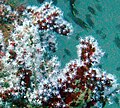| Alcyonium glomeratum | |
|---|---|
 | |
| Alcyonium glomeratum | |
| Scientific classification | |
| Kingdom: | Animalia |
| Phylum: | Cnidaria |
| Subphylum: | Anthozoa |
| Class: | Octocorallia |
| Order: | Malacalcyonacea |
| Family: | Alcyoniidae |
| Genus: | Alcyonium |
| Species: | A. glomeratum |
| Binomial name | |
| Alcyonium glomeratum | |
Alcyonium glomeratum or red sea fingers is a species of soft coral in the family Alcyoniidae. It is found around the southern and western coasts of Britain and Ireland. [2]




